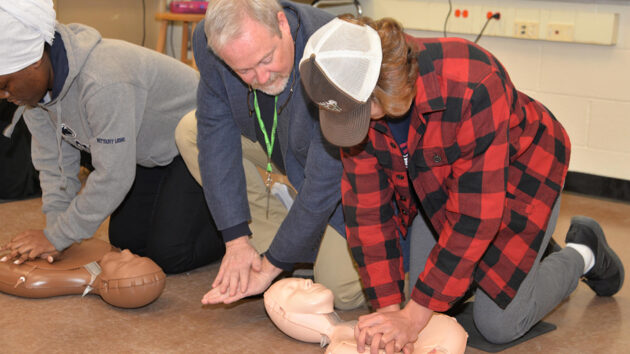What Damar Hamlin’s Collapse Taught us About Cardiac Arrest

In early January, Buffalo Bills player Damar Hamlin went into cardiac arrest — when the heart stops abruptly with little or no warning — shortly after sustaining a hit during a game against the Cincinnati Bengals.
Hamlin was fortunate that his cardiac arrest was recognized rapidly by onlookers and in-house emergency responders. It meant he could get the care he needed immediately after his heart stopped. After receiving CPR along with the use of a defibrillator on the field, Hamlin was transferred to a nearby hospital and released nine days later.
But Hamlin is in the minority. According to 2021 US data for adult out-of-hospital cardiac arrests (OHCA) only, survival to hospital discharge was 9.1% for all EMS-treated non-traumatic OHCA cardiac arrests because, for most people, early recognition and care is rare. Studies show that bystanders only perform CPR in the United States about 40% of the time. Improving this rate is critical to increasing survival from cardiac arrest. That means training laypeople to respond to cardiac arrest by calling 911, using Hands Only CPR® and using an AED if available.
What is cardiac arrest?
During cardiac arrest, the heart stops beating on its own. So, CPR compressions manually keep the heart pumping blood to vital organs. This helps protect the brain, which is vital to surviving cardiac arrest. CPR, specifically early CPR, can double or triple a person’s chance of surviving a cardiac arrest. Between CPR compressions, responders can deliver an electrical shock from an AED, restoring the heart to its normal, consistent rhythm.
Young, athletic people can experience cardiac arrest for a few different reasons. Hamlin’s cardiac arrest might have been caused by a rare phenomenon called commotio cordis, which is when sudden physical trauma to the chest causes sudden death in the absence of apparent cardiac damage.
Each heartbeat begins with an electrical impulse in the heart that causes the muscle of the heart to beat. In healthy hearts, these impulses maintain a steady beat. In commotio cordis, a blunt blow to the chest interrupts the body’s natural electrical pathway, causing an irregular heart rhythm that cannot adequately pump blood to the body.
Hypertrophic cardiomyopathy (HCM), or a thickened heart muscle, is another cause of cardiac arrest that doctors test patients for at the hospital. In young people and athletes, HCM is a more common cause of cardiac arrest that leads to death. In HCM, most often a genetic condition, can cause the heart muscle to thicken, making it more susceptible to an irregular heart rhythm.
No matter the cause of cardiac arrest, Michael Dailey, MD, chief of prehospital and operational medicine and professor of Emergency Medicine at Albany Medical Center, says high-quality CPR begun as quickly as possible, as well as early and effective defibrillation, makes all the difference for people suffering cardiac arrest.
“The more people that learn how to recognize that somebody has collapsed, that they need to call 911, start compressions and get access to a defibrillator as quickly as possible, the more lives we will save,” he says. “The absolute most important thing to do is to recognize an emergency and get hands on that chest to start compressions.”
The importance of timely response
Anyone who witnesses a cardiac arrest outside the hospital can perform CPR, but about 73% of OHCA occurs in homes and private residences. That means that, in most cases, a friend or family member will be the first to respond to cardiac arrest and should know CPR.
Dr. Dailey, along with emergency medicine colleagues at Albany Medical Center, lead trainings to educate community members on cardiac arrest. These trainings introduce best practices on what to look out for during an emergency, as well as the initial actions that can save a life.
For adults and adolescents looking to learn how to respond to cardiac arrest, Hands-Only CPR is an easy-to-learn skill. It requires only two steps: call 911 and use both hands to push hard and fast on the center of the person’s chest. CPR compressions are best at a rate of 100-120 beats per minute.
“Learning the basic skills that are needed to save lives until help arrives is key to being a responsible member of society,” Dailey says. “There are multiple courses that are available that can assist with this training. But more important than the training, is the willingness to get involved, and assist others in the time of crisis.”
Dailey adds that whether you have training or not, 911 communications professionals and call-takers are a great resource. “They are amazing and telecommunicator CPR is a valuable resource for saving lives,” he says “They will stay on the phone with you, talk you through what you are doing, and they are really good at what they do. So, jump in and help out!”